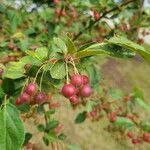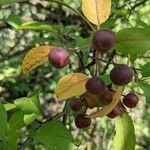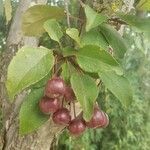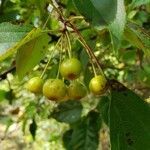Trees to 8 m tall. Branchlets initially dark green, purple or purplish brown when old, terete, initially puberulous, glabrous when old; buds dark purple, ovoid; scales sparsely ciliate at margin. Stipules caducous, linear-lanceolate, 5–6 mm, herbaceous or membranous, sparsely pubescent, margin sparsely glandular denticulate, apex acuminate; petiole 1–3 cm, sparsely puberulous when young, glabrescent; leaf blade ovate or ovate-elliptic, 5–10 × 2.5–4 cm, sparsely puberulous when young, glabrescent, base broadly cuneate, rarely rounded, margin acutely serrulate, apex acuminate. Corymb 4–6 cm in diam., 4–6-flowered; bracts caducous, lanceolate, membranous, margin sparsely glandular serrate when young, apex acuminate. Pedicel 3–6 cm, sparsely villous when young, later glabrous. Flowers 3.5–4 cm diam. Hypanthium campanulate, adaxially glabrous or sparsely villous. Sepals triangular-ovate, 4–5 mm, ca. as long as or shorter than hypanthium, abaxially glabrous, adaxially pubescent, margin entire, apex acuminate or acute. Petals pink in bud, becoming white, obovate, ca. 1.5 cm, base shortly clawed, apex rounded. Stamens 20 unequal, ca. 1/2 as long as petals. Ovary 3-or 4-loculed, with 2 ovules per locule; styles 3(or 4), slightly longer than stamens, tomentose basally. Pome yellowish green, tinged red, ellipsoid or subglobose, ca. 1 cm in diam.; fruiting pedicel 3–6 cm, glabrous; sepals caducous; with a small scar at apex. Fl. Apr–May, fr. Aug–Sep. 2n = 51*, 68*.
A deciduous tree. It grows 12 m tall. It is a broad spreading shape. The bark is purple-brown and flakes into rectangular plates. The freshly exposed bark is orange-brown. The flowers are white and on long stalks. They are 5 cm across and have 5 broadly overlapping petals. They have a scent. The fruit are rounded and flattened. They are deep red and 1 cm across. They hang in clusters on long slender stalks.






